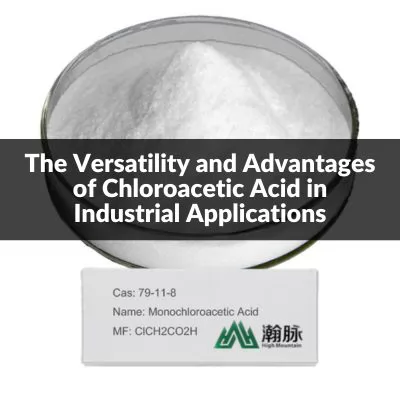
Chloroacetic Acid (CAA) is an important organic compound with a wide range of industrial applications. It is a colorless, pungent-smelling liquid that is easily soluble in water and ethanol. Chloroacetic acid has many unique properties that make it useful in industry. This article will provide an in-depth look at the versatility and advantages of chloroacetic acid in industrial applications, aiming to provide a comprehensive understanding of its applications and properties in different fields.
Table of contents
1. Basic overview of chloroacetic acid
2. Main uses of chloroacetic acid in industry
3. Versatility of Chloroacetic Acid
4. Advantages of chloroacetic acid over other alternatives
5. Properties and characteristics of chloroacetic acid
6. Safety and environmental impact of chloroacetic acid
7.Conclusion
Chloroacetic Acid (CAA) is an organic acid prepared from ethylene through a chlorination reaction. Its chemical structure is CH2ClCOOH, which is a common colorless liquid or white crystalline solid.
It has a range of chemical properties, including strong acidity, good solubility and reactivity. Due to its special structure and properties, chloroacetic acid has important uses in various industrial fields and is an indispensable and important substance in many chemical synthesis and production processes.
Chloroacetic acid has many uses in industry, mainly including the following aspects:
-
Chemical synthesis: Chloroacetic acid, as an important raw material for organic synthesis, is widely used in synthesis reactions in the chemical industry. It can be used to synthesize various organic compounds, such as vinyl polymers, ester compounds, amino acids, etc. Among them, chloroacetic acid is one of the main raw materials for the synthesis of important intermediates such as acetaldehyde and ethyl acetate.
-
Pharmaceutical preparation: In the pharmaceutical industry, chloroacetic acid is often used as an intermediate or raw material for drug synthesis. It can be used to prepare analgesics, anti-inflammatory drugs, antibacterial drugs and other drugs, and can also be used to synthesize precursors for certain biologically active compounds.
-
Agricultural control: Chloroacetic acid has certain bactericidal and herbicidal effects and is widely used as a fungicide, herbicide and plant growth regulator in the agricultural field. It can be used to prevent and manage crop diseases and insect pests, and improve crop yield and quality.
-
Food additive: As a food additive, chloroacetic acid can be used as a preservative and sourness regulator in food. It can inhibit the growth of microorganisms in food, extend the shelf life of food, and give food a certain sour taste to improve taste.
Chloroacetic acid has a variety of functions and is widely used in industrial fields. Here’s a look at the versatility of chloroacetic acid:
-
Solvent: Chloroacetic acid is an excellent organic solvent with good dissolving properties. It can dissolve many organic substances and polymers, including resins, adhesives, dyes, etc., and is often used in the preparation of industrial products such as coatings, paints, and glues.
-
Intermediates: Chloroacetic acid is an important intermediate and raw material for many organic synthesis reactions. Various organic compounds can be synthesized through chloroacetic acid, such as esters, ethers, amino acids, etc. It participates in many important organic synthesis reactions as a starting material or intermediate product.
-
Preservative: Due to its bacteriostatic properties, chloroacetic acid is often used as a preservative. In coatings, paints, glues and other products, adding an appropriate amount of chloroacetic acid can effectively inhibit the growth of bacteria and fungi and extend the service life of the product.
-
Chemical reaction catalyst: Chloroacetic acid can be used as a catalyst for certain chemical reactions to promote the progress of the reaction. For example, in esterification reactions, chloroacetic acid can be used as an esterification agent to catalyze the esterification reaction between alcohol and acid.
Chloroacetic acid has many advantages over other alternatives, making it popular for industrial applications:
-
Low-cost production: The production cost of chloroacetic acid is relatively low, the raw materials are easily available and the preparation process is mature, so it is suitable for large-scale production and wide application. This gives chloroacetic acid a competitive advantage in industrial production.
-
Good effect and stability: Chloroacetic acid shows good effect and stability in industrial applications. It can meet the needs of different industries, including chemical, pharmaceutical, agricultural and food fields. In various processes, chloroacetic acid can play a good role and show high applicability.
-
Environmental friendliness: Chloroacetic acid has a smaller impact on the environment than some other chemicals. Its production process produces relatively few by-products, and waste disposal is relatively simple, which is beneficial to reducing pollution and pressure on the environment. In addition, chloroacetic acid has strong biodegradability, and the degradation products have less impact on the environment, which meets environmental protection requirements.
-
Versatility and wide application: Chloroacetic acid has multiple functions and can be used as a solvent, intermediate, preservative, etc., and is suitable for various industrial fields. It is widely used in chemical synthesis, pharmaceutical preparation, agricultural control, etc. It is a multifunctional chemical.
Chloroacetic acid has the following physical and chemical properties that make it widely used in industry and science:
Physical properties:
-
Density: The density of chloroacetic acid is approximately 1.58 g/cm³ and is usually a liquid or white crystalline solid.
-
Melting point: The melting point of chloroacetic acid is about 63-64°C, and it is a white crystal.
-
Boiling point: The boiling point of chloroacetic acid is about 189°C, and it is usually liquid at room temperature.
-
Solubility: Chloroacetic acid is easily soluble in water and appears acidic in water, but it also has certain solubility with other organic solvents.
-
Volatility: Chloroacetic acid has a certain volatility and will gradually evaporate into a gas at room temperature.
Chemical Properties:
-
Acidity: Chloroacetic acid is a weak acid that is weakly acidic but strong enough to react with bases to form salts and water.
-
Reactivity: Chloroacetic acid has certain chemical reactivity and can participate in esterification, alkylation, chlorination and other reactions.
-
Stability: Chloroacetic acid is relatively stable under the right conditions, but may decompose or react when exposed to high temperatures, pressures, or contact with other chemicals.
-
Flammability: Chloroacetic acid is a flammable substance and may burn when exposed to open flames or high temperatures.
-
Toxicity: Chloroacetic acid has certain toxicity. Long-term exposure or inhalation may cause harm to health. Please pay attention to safe use and handling.
The use of chloroacetic acid in industry and laboratories requires strict compliance with safe operating procedures to reduce harm to human health and the environment. Here is detailed information about the safety and environmental impacts of chloroacetic acid:
safety:
-
Skin and Eye Contact: Chloroacetic acid is a corrosive substance that can cause severe skin and eye burns. When using chloroacetic acid, you should wear personal protective equipment such as protective gloves and goggles, and avoid direct contact with skin and eyes.
-
Inhalation risk: Chloroacetic acid vapor has certain irritation and toxicity. Inhaling high concentrations of chloroacetic acid vapor for a long time may cause respiratory tract irritation, dizziness, nausea and other uncomfortable symptoms. Therefore, ensure good ventilation when handling chloroacetic acid to avoid inhaling its vapors.
-
Fire and Explosion Risk: Chloroacetic acid is a flammable substance and may burn or explode when exposed to open flames or high temperatures. Therefore, when using and storing chloroacetic acid, keep away from fire sources and take fire prevention measures.
-
Storage and Handling: Chloroacetic acid should be stored in sealed containers away from oxidants and strong bases and avoid mixing. When handling chloroacetic acid, proper operating procedures should be followed and protective measures should be taken to reduce the risk of exposure and inhalation.
environmental impact:
-
Water pollution: Large amounts of chloroacetic acid discharge may lead to water pollution and harm aquatic life. Therefore, measures should be taken in industrial production to prevent chloroacetic acid from entering water bodies.
-
Soil contamination: Leaks or improper handling of chloroacetic acid can cause soil contamination, affecting the health of soil ecosystems. Therefore, care should be taken to avoid soil contamination when using and handling chloroacetic acid.
-
Air pollution: The volatility of chloroacetic acid allows it to be easily released into the atmosphere, potentially affecting air quality. Therefore, measures should be taken to reduce volatilization and emissions when handling and storing chloroacetic acid.
When using chloroacetic acid, relevant safety operating procedures and environmental protection regulations should be strictly followed.
In summary, chloroacetic acid, as a versatile organic compound, plays an important role in industrial applications. Not only does it have a wide range of uses, it also offers many advantages, such as low-cost production, good results and stability, and being relatively environmentally friendly. However, when using and handling chloroacetic acid, we must also be aware of its potential safety risks and environmental impacts, and take necessary safety and environmental protection measures. Through correct use and management, we can give full play to the advantages of chloroacetic acid, while minimizing its adverse effects on human health and the environment, and promoting the sustainable development of industrial production. At the forefront of this field is HighMountain Chemical, China's leading chloroacetic acid manufacturer. With a commitment to quality, sustainability and excellence, HighMountain Chemical isn't just participating in the industry; it's leading it. Partner with us and let's open up new avenues for chloroacetic acid applications and improve lives around the world.











